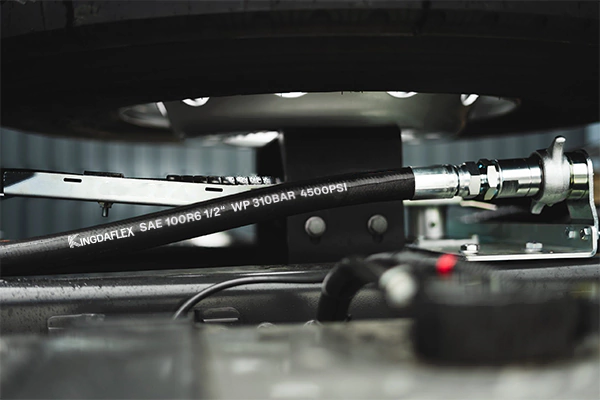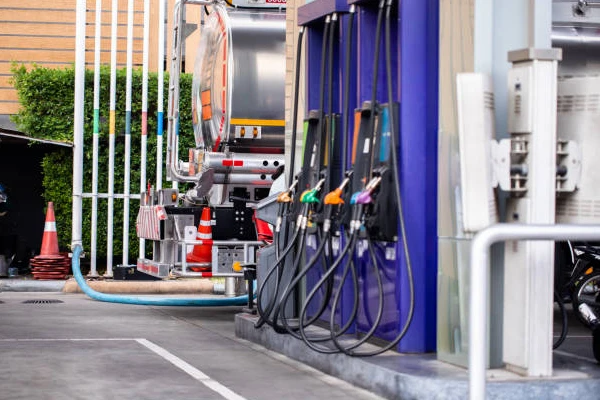If your car’s air conditioning is blowing warm air, a faulty AC hose could be the culprit. This guide will walk you through everything you need to know, from the basic structure and function of these essential components to recognizing common problems. Understanding your AC system is the first step toward a comfortable and cool driving experience.
Air conditioning hoses are far more complex than simple rubber tubes; they are high-tech conduits engineered to withstand extreme temperatures and pressures. Our ultimate guide demystifies these critical components, explaining their role in the refrigeration cycle and highlighting why a high-quality hose is vital for system performance and longevity.
What is Air Conditioning Hose?
An air conditioning (AC) hose is a specialized, multi-layered hose designed to transport refrigerant and lubricant between the various components of a cooling system, such as the compressor, condenser, and evaporator.
Unlike ordinary hoses, AC hoses are engineered to withstand the extreme pressures and temperature fluctuations that occur within the refrigeration cycle.
Their structure typically consists of a low-permeation inner tube to prevent refrigerant from leaking, a reinforcement layer (often made of steel wire or textile) for strength, and a durable outer cover that protects against heat, ozone, and abrasion. These hoses are vital for maintaining system pressure and ensuring the efficient and reliable operation of both automotive and industrial AC units.
What is Air Conditioning Hose Used for?
An air conditioning (AC) hose is a crucial component used to transport refrigerant and lubricant throughout the refrigeration cycle in both automotive and industrial cooling systems. Its primary purpose is to create a sealed pathway for the refrigerant as it changes between a high-pressure liquid and a low-pressure gas, enabling the system to absorb and expel heat.
Key uses of an AC hose include:
- Refrigerant Circulation: The hose connects the system’s core components—the compressor, condenser, receiver-drier, and evaporator—to facilitate the continuous flow of refrigerant.
- Pressure Management: It is designed to withstand the wide range of pressures (from low to very high) and temperatures that occur during the cooling process, preventing leaks and ensuring system efficiency.
- Vibration and Movement Absorption: In a vehicle, the flexible nature of the hose allows it to absorb vibrations from the engine, preventing stress and damage to the rigid components of the AC system.
- Leak Prevention: The multi-layered structure with a low-permeation inner layer is specifically engineered to minimize the escape of costly and environmentally harmful refrigerants.
- Application Versatility: AC hoses are used in a variety of systems, from small automotive AC units to larger industrial and commercial refrigeration applications, ensuring consistent and reliable cooling.
Types of Air Conditioning Hose
While all air conditioning hoses serve the same purpose, they are often categorized by their application and construction. The right type of air conditioning hose is crucial for performance and safety, as it must be compatible with the specific refrigerant and pressure levels of the system it serves.
- Standard Air Conditioning Hose: Designed for traditional R134a systems, these are the most common type of air conditioning hose.
- Reduced Barrier Air Conditioning Hose: A newer, more flexible design for R134a systems, offering a thinner profile while maintaining a leak-proof barrier.
- Green-Stripe Air Conditioning Hose (R1234yf): Specifically engineered for the newer, environmentally-friendly R1234yf refrigerant, identified by a green stripe for easy differentiation.
- Hybrid Air Conditioning Hose: Combines elements of both standard and reduced barrier hoses, suitable for a range of automotive and heavy-duty applications.
- High-Pressure Discharge Air Conditioning Hose: Built with extra reinforcement to withstand the extreme high pressures and temperatures coming directly from the compressor.
How to Repair Air Conditioning Hose in Car?
The repair of a car’s AC hose is a specialized task that requires the right tools and knowledge to handle high-pressure refrigerants safely. It’s often best left to a professional, but understanding the process can help.
Step 1: Diagnosing the Leak and System Recovery
The first step is to accurately locate the source of the leak, which is often done with a UV dye and light. Once the leak is confirmed, a professional technician uses an AC recovery machine to safely extract all remaining refrigerant from the system. This is a critical safety and environmental measure.
The recovered refrigerant is stored in a dedicated tank for recycling. This process ensures no harmful chemicals are released into the atmosphere. This initial step is essential and must be completed before any physical work on the AC hose or its components begins to avoid injury or contamination.
Step 2: Removing the Damaged Hose and Preparing the New One
After the system is fully depressurized, the old, damaged hose is carefully disconnected from its fittings on the compressor, condenser, or evaporator. Any old O-rings and debris are removed to ensure a clean surface. The new, correct replacement hose is prepared for installation.
The new hose is checked for proper length and routing. New O-rings are lubricated with a special PAG or POE oil, which prevents them from tearing and helps create a perfect, leak-proof seal. The new hose is then positioned and secured in place using the proper tools.
Step 3: Evacuating the System and Recharging
Once the new hose is installed, the entire AC system must be evacuated using a vacuum pump. This process removes all air and moisture, which can cause internal damage and acidic buildup if not properly eliminated. The vacuum is held to ensure there are no new leaks.
After a successful vacuum test, the system is ready to be recharged. The correct amount of refrigerant and oil is added using a specialized charging machine, following the manufacturer’s precise specifications. The system is then started and tested to confirm that it is cooling properly.
Can You Use Hydraulic Hose for Air Conditioning?
Generally, you should not use a standard hydraulic hose for an air conditioning system. While both types of hoses are designed to handle pressure, they are engineered for fundamentally different purposes and fluids. Hydraulic hoses are built to contain non-permeating hydraulic fluids at extremely high pressures, often thousands of PSI, and are typically less flexible.
In contrast, AC hoses are specifically designed with a low-permeation inner layer that prevents the escape of refrigerant gas, which is a much more penetrating and volatile substance than hydraulic oil. Using a hydraulic hose could lead to a slow but steady refrigerant leak, causing poor cooling performance, environmental harm, and potential system damage.
- Fluid Compatibility: Hydraulic hoses are made to be compatible with hydraulic fluids and are not designed to be a barrier for refrigerants, which can lead to leaks.
- Permeability: Refrigerants are far more “leaky” than hydraulic fluid. AC hoses have a specialized inner layer to prevent this permeation, which a standard hydraulic hose lacks.
- Pressure and Temperature: While hydraulic hoses can handle higher pressures, AC hoses are built to withstand a wider and more frequent range of temperature fluctuations inherent in the refrigeration cycle.
- Safety and Efficiency: Using the wrong hose can compromise the system’s efficiency, lead to premature failure, and create safety hazards due to refrigerant loss and potential hose bursts.
- Flexibility: Hydraulic hoses are often stiffer due to their heavy reinforcement, making them less suitable for the tight routing and constant vibrations found in automotive AC systems.
How to Choose a Suitable Air Conditioning Hose?
Choosing a suitable air conditioning hose is a critical step for ensuring the long-term performance and safety of an AC system. A number of factors must be carefully considered, including the type of refrigerant, the required pressure rating, and the dimensions of the hose. Selecting the wrong hose can lead to system leaks, inefficiency, and even catastrophic failure.
- Refrigerant Compatibility: The hose must be compatible with the specific refrigerant used in the system, such as R134a or the newer R1234yf. Each refrigerant has different properties and requires a hose with a specific low-permeation inner tube material to prevent leaks.
- Pressure and Temperature Ratings: The hose’s working pressure and burst pressure ratings must be higher than the maximum pressure the system will experience. It must also withstand the temperature extremes of both the refrigerant and the engine bay.
- Size (Inner Diameter): The inner diameter (I.D.) of the hose is crucial for maintaining proper refrigerant flow. If the I.D. is too small, it can restrict flow and cause a pressure drop, leading to poor cooling. If it’s too large, it can affect efficiency.
- Material and Construction: The hose’s construction, including the type of reinforcement (e.g., textile braid, steel wire) and the outer cover material, determines its durability and resistance to abrasion, heat, and ozone.
- Length and Routing: The hose should be long enough to connect components without stretching, but not so long that it becomes coiled or creates unnecessary friction points. Proper routing is essential to avoid contact with moving parts or hot surfaces.
Why Choose Our Air Conditioning Hose?
Choosing our air conditioning hoses means selecting a product built for long-term performance and reliability. We use premium, multi-layered materials that are expertly engineered to withstand the extreme pressures, temperatures, and vibrations inherent in AC systems. This robust construction ensures superior durability and a leak-proof seal, preventing costly refrigerant loss and ensuring your system operates at peak efficiency for years to come.
- High-Pressure Resistance: Our hoses are reinforced with strong materials to handle the high pressures of modern refrigerants like R134a and R1234yf, preventing bursts and failures.
- Superior Durability: The outer cover is resistant to weather, ozone, and abrasion, protecting the hose from engine bay heat and road debris.
- Leak-Proof Design: We use low-permeation inner layers and precision fittings to minimize refrigerant leakage, which saves money and is better for the environment.
- Optimal Performance: By maintaining a consistent, secure flow of refrigerant, our hoses ensure your AC system delivers reliable and powerful cooling, mile after mile.
- Customization and Compatibility: We offer a wide range of sizes and can custom-build hoses and assemblies to ensure a perfect fit for any specific vehicle or industrial application.
Conclusion
In conclusion, the air conditioning hose is a small but mighty component of your cooling system. Its multi-layered, high-pressure design is what allows your AC to perform reliably, mile after mile. By understanding its structure and function, you’re better equipped to maintain your vehicle and address issues before they lead to costly repairs and system failure.
For businesses and professionals seeking a reliable supply, the integrity and performance of your AC hoses are non-negotiable. Don’t compromise on quality that could impact your reputation and your customers’ comfort. Sourcing durable, high-performance hoses is a critical business decision that pays off in both customer satisfaction and long-term savings.
Ensure your AC systems are built to last by choosing high-quality components from a trusted source. For your wholesale air conditioning hose needs, get in touch with our team at Kingdaflex. We offer a comprehensive range of durable, reliable, and expertly-manufactured hoses that meet the highest industry standards, ensuring top performance and value for your business.




